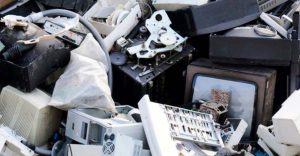Reports from the United Nations indicate that the world’s e-waste has reached unsustainable levels. In 2019 alone, only 17.4% of the total e-waste amounting to 53.6 million tons was recycled. Add this to high water contamination and water pollution and you will agree with the devastating findings from the UN. But who is to blame for this? Is it the consumer, the supplier or the manufacturer? No single entity is responsible for electronics waste. Pollution happens at every point of the supply chain.

Global E-Waste Reaching Alarming Levels (UN News)
Many electronic manufacturing processes are still reliant on energy-intensive processes, hazardous raw materials and the emission of hazardous substances. Suffice to say, some of the beautiful electronic gadgets in your home left a trail of environmental pollution during their manufacture and supply.
MADES has purposed to play its role in promoting eco-friendly and sustainable electronics manufacturing throughout its supply chain.
Steps for Sustainable & Eco-Friendly Processes
Given that the industry is dangerously strolling towards unsustainability, governments and individual players must commit to improved electronics manufacturing. Already, there are efforts towards this end, especially in regards to materials and processes.
Applying a set of five popular principles can help: Reuse, Repair/Remanufacture, Recycling, Recovery and Disposal.
Reuse
Reusing water, energy, materials and heat is the hallmark of a sustainable and eco-friendly manufacturing process. MADES is working alongside this principle by using sustainable materials and minimizing energy consumption as much as possible.
Recycle
I wonder how many consumers are aware that the WEEE Directive gives them the freedom to return used electronics to the point of purchase for responsible recycling. Recycling may not be 100% possible for many electronic parts; the reason recovery is considered another option. Some of these components or parts may be converted into biofuels for energy generation.
MADES is involved in a number of popular recycling programs. For instance, we participate in the MQ-9 Reaper (unmanned aerial vehicle) battery repair program with General Atomics. We manage waste and batteries at the end of their useful life.
We are also active in slag (remains of tin with impurities) management. Our partnership with the collection and recycling company has resulted into sound lead waste management.
Recovery
On recovery, MADES offers a repair service to customers for equipment breakdown (out of warranty, due to defect of use). This approach has helped maintain a flawless engagement with both local and international clients in UK, USA, France, and so on.
Disposal
Disposal is undoubtedly the most common yet unreliable form of handling e-waste. It has a negative impact on the environment and adds no value to the electronics industrial system. This should be the last resource after going through the processes previously mentioned in order to reduce the carbon dioxide emitted by trash burning.
Initiatives for Eco-Friendly and Sustainable Electronics
The Restriction of Hazardous Substances Directive (RoHS) has undergone several updates since it was established in 2006. It seeks to safeguard the European market from hazardous materials and substances used in the manufacturing process. A “CE” mark is shown on compliant items indicating conformity with health, safety and environmental protection standards within the European Economic Area. Materials such as hexavalent chromium (CrVI), cadmium (Cd), mercury (Hg) and most of all lead (Pb) amongst others, play an important role in the electronics manufacturing sector.
Still in Europe and regarding e-waste, there is the Waste Electrical and Electronic Equipment Directive (WEEE Directive) – mentioned previously. The initiative has an ambitious goal of recycling 85% e-waste.
A popular program in the United States is the Electronic Waste Recycling Act of 2003 (EWRA) in California. This initiative is actually a derivative of the RoHS, but it concentrates on mercury, lead, cadmium and hexavalent chromium in certain items. Within the same state, the RoHS is also used for electric products such as lighting tubes and bulbs.
In Asia, the Administrative Measure on the Control of Pollution Caused by Electronic Information Products in China, better known as China RoHS, is doing a good job controlling hazardous materials in the electronics industry.
Sustainability and Eco-friendliness by MADES
As a reputable contract manufacturer, MADES is keen to use energy-efficient processes, earth-friendly materials and sustainable processes. We have purposed to play our role in promoting eco-friendly and sustainable electronics manufacturing throughout our supply chain.
We comply with a number of international standards including REACH, ROHS and Conflict Minerals. Our customes can rest assured that all the components and systems are compliant, and have met all reporting requirements. Some pointers to this dedication are:
- First company in the Raytheon Corporation to qualify for RoHS processes
- Partners with certified waste management policies
- All activities aligned to requirements of ISO 14001 Environmental certification
- Replaced traditional lights with LEDs
- Regularly conducts awareness campaigns with collection of wastes such as medicines and plastics
Would you like to engage with us for sustainable electronics? Get in touch.





